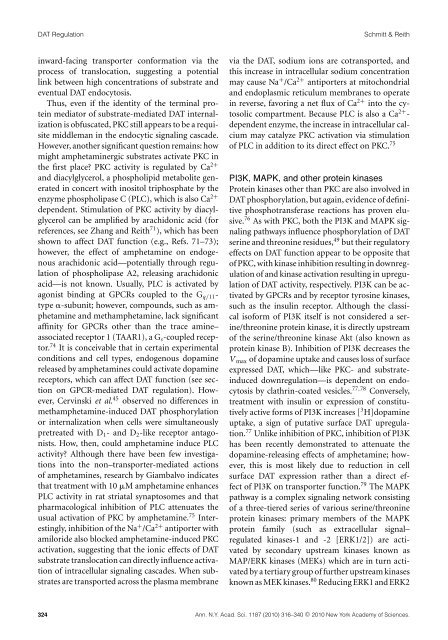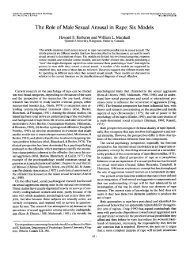Regulation of the dopamine transporter - Addiction Research ...
Regulation of the dopamine transporter - Addiction Research ...
Regulation of the dopamine transporter - Addiction Research ...
You also want an ePaper? Increase the reach of your titles
YUMPU automatically turns print PDFs into web optimized ePapers that Google loves.
DAT <strong>Regulation</strong> Schmitt & Reith<br />
inward-facing <strong>transporter</strong> conformation via <strong>the</strong><br />
process <strong>of</strong> translocation, suggesting a potential<br />
link between high concentrations <strong>of</strong> substrate and<br />
eventual DAT endocytosis.<br />
Thus, even if <strong>the</strong> identity <strong>of</strong> <strong>the</strong> terminal protein<br />
mediator <strong>of</strong> substrate-mediated DAT internalization<br />
is obfuscated, PKC still appears to be a requisite<br />
middleman in <strong>the</strong> endocytic signaling cascade.<br />
However, ano<strong>the</strong>r significant question remains: how<br />
might amphetaminergic substrates activate PKC in<br />
<strong>the</strong> first place? PKC activity is regulated by Ca 2+<br />
and diacylglycerol, a phospholipid metabolite generated<br />
in concert with inositol triphosphate by <strong>the</strong><br />
enzyme phospholipase C (PLC), which is also Ca 2+<br />
dependent. Stimulation <strong>of</strong> PKC activity by diacylglycerol<br />
can be amplified by arachidonic acid (for<br />
references, see Zhang and Reith 71 ), which has been<br />
shown to affect DAT function (e.g., Refs. 71–73);<br />
however, <strong>the</strong> effect <strong>of</strong> amphetamine on endogenous<br />
arachidonic acid—potentially through regulation<br />
<strong>of</strong> phospholipase A2, releasing arachidonic<br />
acid—is not known. Usually, PLC is activated by<br />
agonist binding at GPCRs coupled to <strong>the</strong> Gq/11type<br />
�-subunit; however, compounds, such as amphetamine<br />
and methamphetamine, lack significant<br />
affinity for GPCRs o<strong>the</strong>r than <strong>the</strong> trace amine–<br />
associated receptor 1 (TAAR1), a Gs-coupled receptor.<br />
74 It is conceivable that in certain experimental<br />
conditions and cell types, endogenous <strong>dopamine</strong><br />
released by amphetamines could activate <strong>dopamine</strong><br />
receptors, which can affect DAT function (see section<br />
on GPCR-mediated DAT regulation). However,<br />
Cervinski et al. 45 observed no differences in<br />
methamphetamine-induced DAT phosphorylation<br />
or internalization when cells were simultaneously<br />
pretreated with D1- andD2-like receptor antagonists.<br />
How, <strong>the</strong>n, could amphetamine induce PLC<br />
activity? Although <strong>the</strong>re have been few investigations<br />
into <strong>the</strong> non–<strong>transporter</strong>-mediated actions<br />
<strong>of</strong> amphetamines, research by Giambalvo indicates<br />
that treatment with 10 �M amphetamine enhances<br />
PLC activity in rat striatal synaptosomes and that<br />
pharmacological inhibition <strong>of</strong> PLC attenuates <strong>the</strong><br />
usual activation <strong>of</strong> PKC by amphetamine. 75 Interestingly,<br />
inhibition <strong>of</strong> <strong>the</strong> Na + /Ca 2+ antiporter with<br />
amiloride also blocked amphetamine-induced PKC<br />
activation, suggesting that <strong>the</strong> ionic effects <strong>of</strong> DAT<br />
substrate translocation can directly influence activation<br />
<strong>of</strong> intracellular signaling cascades. When substrates<br />
are transported across <strong>the</strong> plasma membrane<br />
via <strong>the</strong> DAT, sodium ions are cotransported, and<br />
this increase in intracellular sodium concentration<br />
may cause Na + /Ca 2+ antiporters at mitochondrial<br />
and endoplasmic reticulum membranes to operate<br />
in reverse, favoring a net flux <strong>of</strong> Ca 2+ into <strong>the</strong> cytosolic<br />
compartment. Because PLC is also a Ca 2+ -<br />
dependent enzyme, <strong>the</strong> increase in intracellular calcium<br />
may catalyze PKC activation via stimulation<br />
<strong>of</strong> PLC in addition to its direct effect on PKC. 75<br />
PI3K, MAPK, and o<strong>the</strong>r protein kinases<br />
Protein kinases o<strong>the</strong>r than PKC are also involved in<br />
DAT phosphorylation, but again, evidence <strong>of</strong> definitive<br />
phosphotransferase reactions has proven elusive.<br />
76 As with PKC, both <strong>the</strong> PI3K and MAPK signaling<br />
pathways influence phosphorylation <strong>of</strong> DAT<br />
serine and threonine residues, 49 but <strong>the</strong>ir regulatory<br />
effects on DAT function appear to be opposite that<br />
<strong>of</strong> PKC, with kinase inhibition resulting in downregulation<br />
<strong>of</strong> and kinase activation resulting in upregulation<br />
<strong>of</strong> DAT activity, respectively. PI3K can be activated<br />
by GPCRs and by receptor tyrosine kinases,<br />
such as <strong>the</strong> insulin receptor. Although <strong>the</strong> classical<br />
is<strong>of</strong>orm <strong>of</strong> PI3K itself is not considered a serine/threonine<br />
protein kinase, it is directly upstream<br />
<strong>of</strong> <strong>the</strong> serine/threonine kinase Akt (also known as<br />
protein kinase B). Inhibition <strong>of</strong> PI3K decreases <strong>the</strong><br />
V max <strong>of</strong> <strong>dopamine</strong> uptake and causes loss <strong>of</strong> surface<br />
expressed DAT, which—like PKC- and substrateinduced<br />
downregulation—is dependent on endocytosis<br />
by clathrin-coated vesicles. 77,78 Conversely,<br />
treatment with insulin or expression <strong>of</strong> constitutively<br />
active forms <strong>of</strong> PI3K increases [ 3 H]<strong>dopamine</strong><br />
uptake, a sign <strong>of</strong> putative surface DAT upregulation.<br />
77 Unlike inhibition <strong>of</strong> PKC, inhibition <strong>of</strong> PI3K<br />
has been recently demonstrated to attenuate <strong>the</strong><br />
<strong>dopamine</strong>-releasing effects <strong>of</strong> amphetamine; however,<br />
this is most likely due to reduction in cell<br />
surface DAT expression ra<strong>the</strong>r than a direct effect<br />
<strong>of</strong> PI3K on <strong>transporter</strong> function. 79 The MAPK<br />
pathway is a complex signaling network consisting<br />
<strong>of</strong> a three-tiered series <strong>of</strong> various serine/threonine<br />
protein kinases: primary members <strong>of</strong> <strong>the</strong> MAPK<br />
protein family (such as extracellular signal–<br />
regulated kinases-1 and -2 [ERK1/2]) are activated<br />
by secondary upstream kinases known as<br />
MAP/ERK kinases (MEKs) which are in turn activated<br />
by a tertiary group <strong>of</strong> fur<strong>the</strong>r upstream kinases<br />
known as MEK kinases. 80 Reducing ERK1 and ERK2<br />
324 Ann. N.Y. Acad. Sci. 1187 (2010) 316–340 c○ 2010 New York Academy <strong>of</strong> Sciences.










